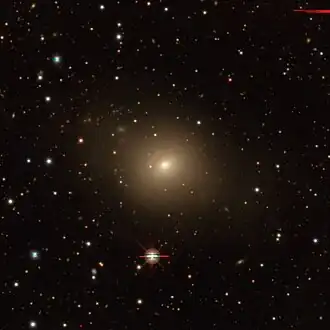NGC 5626
| NGC 5626 | |
|---|---|
 NGC 5626 imaged by Legacy Surveys | |
| Observation data (J2000 epoch) | |
| Constellation | Hydra |
| Right ascension | 14h 29m 49.1156s[1] |
| Declination | −29° 44′ 54.545″[1] |
| Redshift | 0.022983[1] |
| Heliocentric radial velocity | 6890 ± 12 km/s[1] |
| Distance | 342.5 ± 24.0 Mly (105.02 ± 7.36 Mpc)[1] |
| Apparent magnitude (V) | 12.9[1] |
| Characteristics | |
| Type | SA(s)0+[1] |
| Size | ~205,300 ly (62.94 kpc) (estimated)[1] |
| Apparent size (V) | 1.2′ × 1.0′[1] |
| Other designations | |
| ESO 447- G 008, 2MASX J14294908-2944544, MCG -05-34-015, PGC 51794[1] | |
NGC 5626 is a lenticular galaxy in the constellation of Hydra. Its velocity with respect to the cosmic microwave background is 7,120 ± 20 km/s, which corresponds to a Hubble distance of 105.0 ± 7.4 Mpc (~342 million light-years). It was discovered by British astronomer John Herschel on 30 March 1835.[2]
One supernova has been observed in NGC 5626: SN 2023kyb (Type Ia, mag. 17.679) was discovered by ATLAS on 17 June 2023.[3]
See also
References
- ^ a b c d e f g h i j "Results for object NGC 5626". NASA/IPAC Extragalactic Database. NASA and Caltech. Retrieved 20 July 2024.
- ^ Seligman, Courtney. "New General Catalogue Objects: NGC 5626". Celestial Atlas. Retrieved 12 December 2024.
- ^ "SN 2023kyb". Transient Name Server. IAU. Retrieved 12 December 2024.
External links
 Media related to NGC 5626 at Wikimedia Commons
Media related to NGC 5626 at Wikimedia Commons- NGC 5626 on WikiSky: DSS2, SDSS, GALEX, IRAS, Hydrogen α, X-Ray, Astrophoto, Sky Map, Articles and images